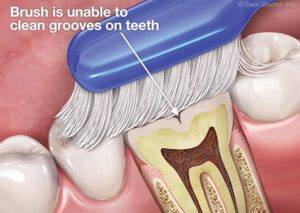A good oral hygiene routine and a healthy diet are the best way to prevent plaque build-up in the mouth. Brushing and flossing are the best ways to help prevent cavities, but even the most thorough brushing cannot always reach the nooks and crannies in the back teeth (molars). Molars are referred to as the primary chewing surfaces in the mouth. They are a rough and uneven surface for leftover food and cavity-causing bacteria to hide. The chewing surfaces of the molar and premolar teeth have grooves a.k.a fissures, that make them vulnerable to decay.
These fissures and pits can be deep and difficult to clean. Some are even too narrow for a toothbrush’s bristle. This is where plaque and bacterial acid can build up and attack the enamel of the tooth, eventually causing cavities. So what is the cure for these hard to reach places? Dental sealants!

Dental sealants are plastic coatings that are usually placed on the molars and premolars. They fill in the tooth’s depressions to prevent bacteria build up in the fissures. “Think of them as raincoats for your teeth. When the cavity-causing bacteria that live in everyone’s mouth meet leftover food particles, they produce acids that can create holes in teeth. These holes are cavities. After sealant has been applied it keeps those bits of food out and stops bacteria and acid from settling on your teeth—just like a raincoat keeps you clean and dry during a storm.” – Mouth Healthy
The procedure is quick and painless. The dentist first thoroughly cleans the tooth’s nooks and crannies before sealing it up. After the teeth are dry from the cleaning, an acidic gel solution is applied to roughen the surface. This gel roughs up the surface of the tooth to create a strong bond between the tooth and the sealant. Once the gel is rinsed off and dried again, the plastic sealant (made of plastics or other dental materials) is bonded to the tooth. Dental sealants can be clear, white or have a slight tint depending upon the dental sealant used. The dentist may use a special light may to speed up the hardening process.
Sealants are placed on both adults and children, once they have grown in their permanent molars and premolars. They are usually reapplied every few years. During your regular dental visits, the dentist checks the condition of the sealant and can reapply as needed. Dental sealants can even be used over areas of early decay to prevent further damage to the tooth.
Keep in mind, dental sealants are not a substitute for brushing and flossing the back teeth. They definitely help to keep cavities from forming and may even stop early stages of decay from becoming a full-blown cavity! Some sealants have been shown to reduce the risk of decay by nearly 80% in molars.
Make an appointment today at Beautiful Smiles of Long Island for your biannual dental visit. We can assess the grooves of your teeth and determine if dental sealants are right for you!







